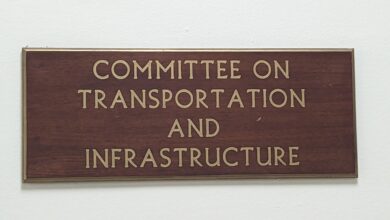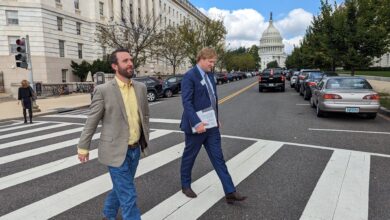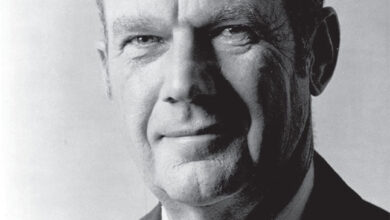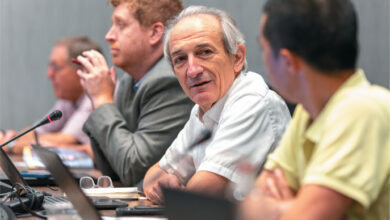Storied Asphalt Advocate Retires
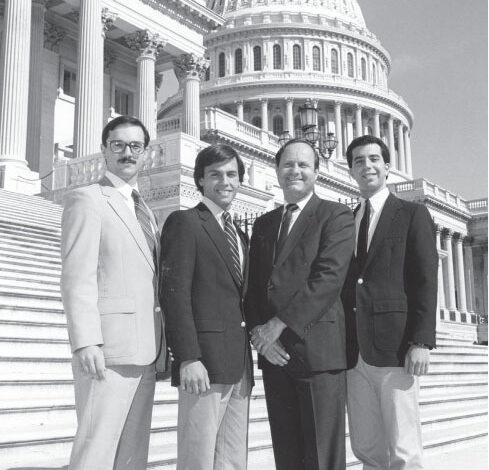
Jay Hansen nabbed first NCAT earmark, helped establish PAC, and secured billions in asphalt funding in 24-year NAPA career.
BY TY JOHNSON MANAGING EDITOR
The palm-sized asphalt sample hits the wooden table with a dull clap.
Over the years, dozens of Congressional aides have sat across from NAPA Executive Vice President for Advocacy Jay Hansen on Capitol Hill, but he said the description tends to hit the same notes.
“You use this every day. You touch it every day. It’s completely recyclable, and I’m going to talk to you about it today,” has been the preamble to many an understanding of asphalt pavement for staffers, both in Congress and across the country.
Martin T. Whitmer, Jr, partner at Whitmer & Worrall, LLC, part of NAPA’s external lobbying arm, said Hansen went into every meeting, at every level, prepared.
“He’s going to know the name of the contractors in their district. He never wings it,” he said of Hansen, describing him as the primary contact on asphalt for Capitol Hill. “He’s the asphalt person in D.C., bar none. And he hasn’t changed. A lot of folks come to D.C. and get changed. They find they have to get political or hire a public relations firm, but Jay has just been steadily true to the industry; a marvelous, dedicated advocate who doesn’t blow in the winds. The practical effect of that is that Congress and staff know who to call.”
NAPA members, too, as Jay Lemon of Haskell Lemon Construction pointed out that “D.C. Jay” has led and directed NAPA’s legislative efforts since his father, Larry, was at the helm, although he noted that it’s not just Hansen’s accomplishments that set him apart.

“Jay Hansen has been so much more than just our excellent legislative director at NAPA, but also a personal friend, a family friend and a mentor,” Lemon said.
And the ripple effect of that dedication, even in the fast-moving world of legislative relations, has had other impacts, including on other members of the lobbying team, like Whitmer.
“He makes me want to be a franchise player,” Whitmer said. “We are on the asphalt team.”
Even franchise players hang it up, though, and when Hansen retires from NAPA in the first quarter of 2023, he’ll be leaving behind not only a career at the association that spanned nearly a quarter-century, but a legacy of disarming pragmatism that stretches back to the dawn of the Reagan era.
NAPA President and CEO Audrey Copeland said Jay was instrumental in bringing her aboard a decade ago and there’s no doubt he has left a mark on the association.

“When I came to NAPA over 10 years ago, Jay welcomed me and quickly went to work teaching me about industry advocacy, in particular, active legislation to secure asphalt pavement research funding,” she said. “He knew that NAPA was most powerful and successful when advocacy and engineering worked hand in hand. Jay led the effort to secure millions of dollars for research and implementation administered by the Federal Highway Administration and Federal Aviation Administration all while ensuring legislation did not pass that may harm a competitive, open market for pavements. Jay and I worked on complex white papers together spanning cost analyses to fair competition. He not only had foresight on these issues and what it took to ‘work’ these issues with Congress, he had the work ethic and skills to execute. Jay has asphalt in his blood and is completed dedicated to our industry—that brought me comfort as I moved into the role of his supervisor. I hope Jay takes some pride knowing he played a role in mentoring me and my career successes—as he’s done with countless others. I’ve also had the privilege of knowing Jay and his family personally as we’re neighbors. While Jay’s dedication to NAPA is impressive, more impressive is his dedication and love for his family and their passions. Jay will be greatly missed on many levels.”
FROM BUFFALO TO BILLS
Coming of age in Western New York just before The Brady Bunch entered syndication meant after two years at the University of Buffalo, the call to head west rung loud for young Jay Hansen.
“In 1980, everybody was either moving to Florida, or out to California. I remember seeing the Bradys bringing in the Christmas tree while wearing light jackets. So, I moved to the warmer weather.” His network led him to San Diego, where the newly established 44th Congressional District was represented by Jim Bates.
After establishing residency in the Golden State, he enrolled at San Diego State University, where a professor inspired him to major in political science. Hansen needed an internship as part of his senior capstone in 1985, so he went to work for Bates in the district office in California. After graduating, he began working full time on constituent case work, which meant traveling across the city pursuing potential policy solutions to local environmental and immigration issues.
“I was learning more about San Diego through my internship. I was traveling. And then the Congressman had an opening in Washington in 1986. I was weighing weather versus career,” he said of the ultimate decision to move to the nation’s capital. “It was the best move I ever made.” It didn’t necessarily feel like it at first. Hansen remembers that just as he was named legislative assistant in D.C., President Ronald Reagan announced his veto of the highway bill. But what happened next stuck with him.
“That was my first taste of legislation on transportation,” he said. “I really didn’t know what I was doing, but as I look back on it, it was an interesting time: Reagan vetoed A young Jay Hansen stands with Rep. Jim Bates (D-CA) and the legislative team. Jay Staffing NAPA Legislative Committee Meeting. Jay in his D.C. office in the 1980s. the highway bill over earmarks, and the reason his veto was overridden was because of earmarks. Democrats and Republicans banded together to override the president’s veto. That’s how popular highway bills were back then. They were bipartisan.”
After a promotion, to legislative director, Hansen found himself working on the U.S. House Energy and Commerce Committee issues alongside such statesmen as Henry Waxman of California and the late John Dingell of Michigan, history’s longest-serving member of Congress, on bills ranging from Navy helicopter safety to landmark legislation still on the books today, like the Clean Air Act.
But it was through the Transportation and Infrastructure Committee that Hansen began working with bipartisan dealmakers, like Congressman Bob Clement, who learned the pragmatism from his work at a predecessor to the Tennessee Public Utility Commission.
By the time he joined Clement’s legislative staff, Congress was putting together another highway bill, but under a slightly more conspicuous name: The Intermodal Surface Transportation Efficiency Act (ISTEA).
“Intermodal wasn’t even a word in the dictionary,” Hansen says of the early ‘90s, when he often had to explain what he meant by the planned synchronization of highways, transit, rail, and air. “It works more efficiently if you think of it as an intermodal system. The whole idea is that it’s all woven together in the fabric of society—that’s what intermodal meant then.”
That work led Associated General Contractors of America (AGC) to recommend Hansen for a legislative job at what is today the American Council of Engineering Companies (ACEC), and this time, Hansen had more to consider than weather. Following the marathon legislation session associated with the Contract With America after the 1994 Republican House takeover, Hansen was looking for more time with his family and young daughter, Chaska.
In his new role with ACEC, Hansen could continue doing what he loved to do most: explaining the finer points of civics to anyone who is interested.
“What I really like to do that carries over to this day is explaining the process,” he said. “Explaining how bills become law, explaining to constituents that there is more to an issue, and sharing both sides and letting them walk away with a deeper understanding of how Congress works—in terms that people can understand so they know what’s really in these bills and what it means for their business.”
A regular reader of the Congressional Record, a daily digest of floor debates, introduced bills, and amendments, Hansen’s dedication to his craft led to a career highlight when he discovered an amendment unaligned with ACEC interests.
“The way I discovered it was that we used to get the Congressional Record hard copy, and in the back are all the amendments that are introduced. We didn’t have the internet like we have today. You would thumb through.”
Hansen noted that he learned to read it backwards, since amendments were never up front.
“It was an appropriations bill and there was this amendment that said before you contract out engineering services you had to do a cost-benefit analysis.”
If passed, the amendment could have effectively ended the contracting out of engineering services for state DOTs, so even though he was still fairly new to ACEC, Hansen had a hunch he needed to elevate it to the leadership.
Awaiting the copy of the full legislation at the fax machine, alongside the organization’s legal counsel, Hansen said he vividly remembers what was said after they confirmed the legislation could cause major issues for projects across the nation.
“I remember pulling the sheets off. The boss says, ‘Jay! Contact AASHTO! Contact ARTBA! Contact AGC! We’ve got to build a coalition.’” using the acronyms for the American Association for State Highway and Transportation Officials, the American & Transportation Builders Association, and the American General Contractors, respectively.
“And I don’t know who these groups are. It was all new to me, but within 24 hours we were able to pull together and defeat the amendment.”
The next day, Hansen brought in his VHS recording of the late-night debate where the amendment was defeated in a roll call vote. The entire staff was riveted while watching the moments in the speech when Chairman Bud Shuster sounded incredulous that the amendment had been proposed while namedropping ACEC as an opponent to the bill.
“The whole room erupted,” Hansen said. “It made people realize what government affairs could do.”
NAPA AND NEW CHALLENGES
In late 1998, Hansen heard of an opening at NAPA, where the pursuit of research funding for the National Center for Asphalt Technology (NCAT) in Alabama was top of mind.
Impressed by his autonomous working style, then-President Mike Acott hired him and by the time the 2001 Transportation Appropriations bill was passed, Hansen had secured the support of Sen. Richard Shelby on the way to NCAT’s first earmark: $1.5 million for pavement research.
Hansen said his experience “on the Hill” prepared him for the politics of pavement preferences. In 2003, when he heard the Federal Aviation Administration (FAA) reauthorization bill would include a research grant for concrete, he contacted the offices of Sen. John McCain of Arizona with an explanation of how most runways, aprons, and taxiways in the country were paved with asphalt. The solution he proposed was the addition of “and asphalt” in the language. The change went through.
When his concrete counterpart heard the news, he called Hansen up and accused him of cutting the aviation research funding for concrete in half.
“I said, that may be true, but if we work together, we can double the size of the program,” Hansen said. “And from that moment on, we worked together. Despite all the noise around pavement-type selection and, in fact, because of us working with concrete, I can show we have $140 million for research for asphalt that was supported by both NAPA and the concrete industry.”
“Whether it’s Democrats, Republicans, engineers, or government affairs, it’s not one person making all this happen: It’s a team effort,” he said. “Both internally, within NAPA, and externally, I’m a big believer in partnership, and if we’re going to decarbonize this industry, we have to do it in partnership with road owners, specifiers, and the entire industry, including suppliers and equipment manufacturers, in order to succeed and grow our market.”
Whitmer said he remembered Hansen insisting on inclusion, even as he was being hired, because the concrete lobby was attempting to tip the scales in its favor.
“That’s a rarity. He works with other associations, and after the consolidation and conflicts, Jay gives credit to the partners,” Whitmer said, noting a more recent example was his reaching out to the National Stone, Sand & Gravel Association (NSSGA). and Sen. Tammy Baldwin of Wisconsin to change Buy America language that, if ratified, could be detrimental to industry. “We’re much better united as an industry, across the board, than divided.”
After his early NAPA career wins, Hansen set his sights on growing the visibility of asphalt advocacy, finding novel ways to engage more with the membership.
“There were no asphalt advocates back then,” Hansen said, noting that he was largely tasked with representing the asphalt industry in its entirety.
Worse, an industry-wide distaste for political action committees (PAC) had made it difficult to keep asphalt on the minds of members of Congress as lobbying re-invented itself in the mid-2000s. Without a PAC, Hansen again trusted his coalition-building instincts and set upon achieving legislative objectives the old-fashioned way: through partnerships.
Beginning with a cooperative fly-in with NSSGA, the Transportation Construction Coalition (TCC) proved to be a practical way to bring together stakeholders with overlapping interests to engage with their Congressional representatives on industry-wide priorities. The resulting annual event, the TCC Fly-In, has become the premiere annual legislative fly-in for the transportation construction industry.
“If you’re not up there making the case, there are others ready to make the case against you,” he said, pointing to the now bankrupt Highway Trust Fund, which was withered away over years of nonhighway spending. “Now we have to find another way to pay for these programs because we haven’t raised the gas tax since 1992.”
ARTBA President and CEO Dave Bauer said Jay worked with him on countless policy challenges, with Hansen never thinking about politics, only what was best for members and the nation. He fondly recalls the work to bring together other peer organizations for a fly-in.
“What started with a handful of groups hosting a joint-lobbying day has grown to focal point of our industry’s advocacy efforts,” Bauer said. “Jay’s enthusiasm, commitment and leadership was integral to the evolution and success of this critical event.”
Christian Zimmermann of Pike Industries, A CRH Company, said Jay’s laser focus on legislation impressed him nearly two decades ago when he began participating in NAPA regularly, eventually coaxing him onto the Legislative Committee. Zimmermann said he was concerned about funding after the sunset of the Transportation Equity Act for the 21st Century (TEA-21).
“NAPA was all about the technical side of asphalt,” Zimmermann recalls. “It just didn’t seem to me that there was a whole lot of emphasis on the funding piece. I knew that money came from the federal government and that the gas tax was an underlying user fee that funded it, but I didn’t realize how it was allocated or appropriated.”
“If you’re going to run a hot mix asphalt company that does a lot of U.S. DOT work, you’re going to need to know who your customer is and how it all works. Jay was a wealth of knowledge.”
Still, what Hansen said was missing from the NAPA approach was political advocacy, but even after getting the PAC started, other associations were working more aggressively to grow influence.
“Jay knew that our marketing effort was walking the halls of Congress, and having the PAC behind us would open doors,” Zimmermann said. “He knew the value then. Getting to know Congress is really important to our future in terms of funding, and the best way to fund that was the PAC and he knew that.”
Donating to the campaigns of candidates who supported federal highway funding proved to be a great door opener and put NAPA on the radar of the power brokers of Washington in a meaningful way that also added member benefit. Producer members were invited to present the check to their representative as part of a plant tour, educating members of Congress while creating an opportunity for constituent engagement.
“Being that 65 percent of the market is publicly funded highway, it’s an important element for members to be involved in,” Hansen said, adding that he is happy to know that even as he retires, NAPA is making plans to grow the PAC through a new funding approach that members can understand and have confidence in.
Jay says he can see the growth through involvement with the state asphalt pavement associations, who have gotten involved at the grassroots level and developed advocacy programs of their own while helping the NAPA PAC to better connect members with their representatives.
Many other “special projects” Hansen took on at NAPA led to special results, like his involvement on the Associate Member Council when Chairman Peter Wilson led his campaign to have the NAPA Research and Education Foundation endowed so it could continue supporting its NAPA Cares program, which was based on a similar program in Missouri that provides financial support for the surviving family in the event of a fatality in a work zone. The AMC raised more than its $500,000 endowment goal in a single fundraiser, safeguarding the fund against ever running out.
Mike Blantz of Honeywell Maxon said he first met Jay when he became the NAPA liaison to the AMC. “Jay was truly interested in the projects of the Associate Members Council; specifically in our work to fund and endow the NAPA Care project that the association took on to financially assist families of loved ones, employed by NAPA members, who died while in the performance of their job,” Blantz said. “In 2018, I became Chairman of the AMC, and it was then that I could really appreciate Jay’s dedication to NAPA and its members. By the time I ended my chairmanship in 2020 NAPA Care was endowed, and we reached that goal because of Jay’s behind the scenes work and dedication to the project.”
Ben Brock of Brock Industries said he remembers Jay’s first annual meeting and working together on AMC and lauded his handling of “strong personalities” from within both the industry and the halls of Congress.
“In hindsight, he put up with a lot from me and my comments,” Brock said. “He is such a pro. I’ve seen him handle some interesting moments with best-in-class responses in committees, in the hallways at NAPA meetings, at trade association shows, and on the Hill in Washington DC.”
Hansen’s work with the AMC gave him a new avenue for meeting people across the industry, from additives to tax credits, and his involvement with the Hot Mixers, now the IMPACT Leadership Group, means he still has those connections to this day.
Brock was part of the Hot Mixers when Jay came aboard.
“I think he came to his first Hot Mixers meeting wondering what the heck he was doing there, but in the end, he appreciated the group. He got to know everyone and realized he would be working with the group members for many years to come,” Brock said, noting that 11 current members on the NAPA Board started out as Hot Mixers. “Jay got unfiltered, direct, and, hopefully he recalls, humorous comments from that group.”
Hansen, too, noted that many of those young leaders are leading their own companies now.
“The Hot Mixers I worked with early in my career are now running the companies. I am just amazed at that,” he said. “That connection is so valuable, and that’s what I got out of it. And it helped me to do my job a lot better.”
Paula Shuford with the Herman Grant Company remembers that Jay continued serving as AMC liaison through the onset of the 2020 pandemic and helped guide her as chair.
“He and I bonded over our love of all things political and our beautiful daughters,” she recalled. “While I was the Chair of the Associate Member Council, Jay was my liaison to NAPA. He went out of his way to make sure I was thoroughly prepared for all the Zoom meetings we experienced during the long pandemic. Jay is one of the most thoughtful and gracious men I have ever met.”
THE FUTURE OF ASPHALT ADVOCACY
Hansen said the focus now and in the near future will be implementation of what became the final highway funding bills he championed: Infrastructure Investment & Jobs Act (IIJA) and the Inflation Reduction Act (IRA).
Whitmer said the two of them showed up at all of the hearings and votes, just as Hansen had learned as a staffer decades before.
The events are a bit more crowded than when he began, however, as congressional focus on construction and infrastructure has sharpened.
“There’s been such an explosion of interest in construction materials now,” he said. “When I started, just to get into the office to explain this was difficult. We did have issues and they were highly technical for congressional staff to deal with. Today, there’s staff assigned in these committees that deal with construction materials. That says that we are on the radar screen, and it could be good, or it could be bad and the best thing to do is to be at the table, show up, and understand what they’re thinking.”
Identifying issues in advance will continue to be a priority for asphalt advocates, he said, as plastics in asphalt mandates, fossil fuel bans, and other well-intentioned regulations could very well impact markets if the industry doesn’t keep a watchful eye on the legislation coming from Congress as well as the policies coming from federal agencies.
“Following that will be reauthorization of the next highway bill, which will happen in the next administration,” Hansen said, noting that NAPA is partnering on a study with the Eno Center for Transportation aimed at highway funding beyond 2025. “We need to find some way to fund this Highway Trust Fund. And so, we’re doing the early work now to get ready for that in the next Administration.”

